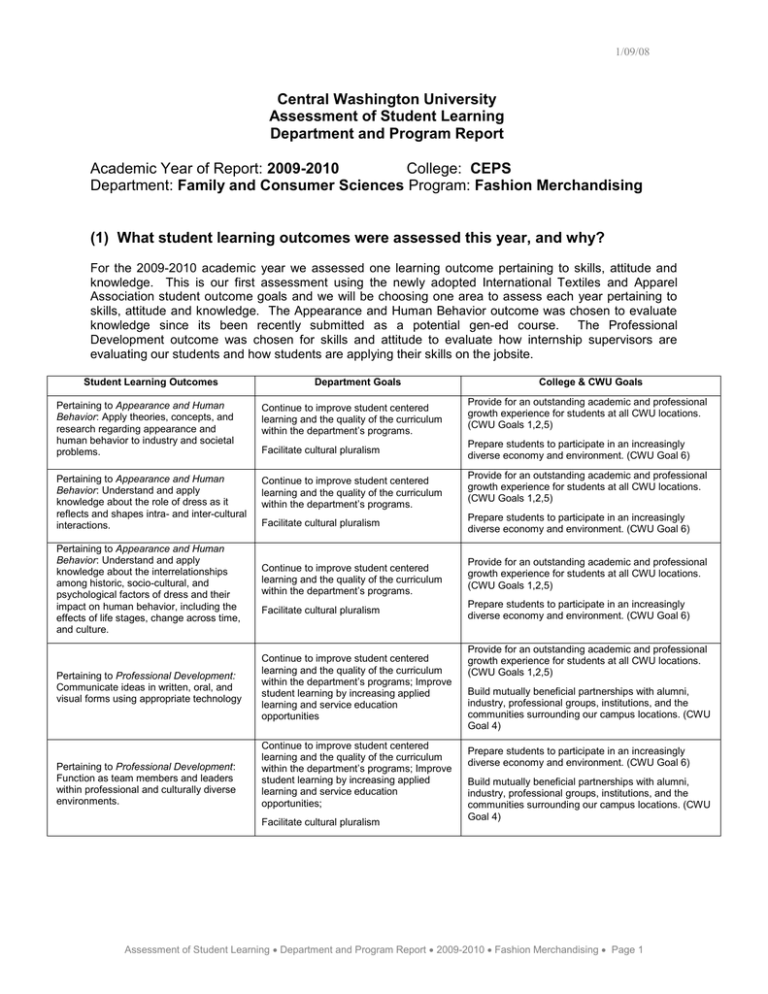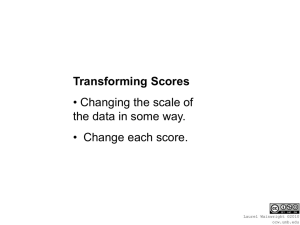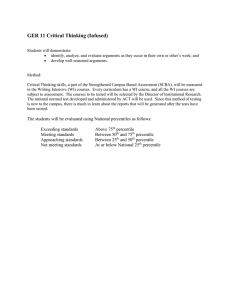2009-2010 CEPS Family and Consumer Sciences
advertisement

1/09/08 Central Washington University Assessment of Student Learning Department and Program Report Academic Year of Report: 2009-2010 College: CEPS Department: Family and Consumer Sciences Program: Fashion Merchandising (1) What student learning outcomes were assessed this year, and why? For the 2009-2010 academic year we assessed one learning outcome pertaining to skills, attitude and knowledge. This is our first assessment using the newly adopted International Textiles and Apparel Association student outcome goals and we will be choosing one area to assess each year pertaining to skills, attitude and knowledge. The Appearance and Human Behavior outcome was chosen to evaluate knowledge since its been recently submitted as a potential gen-ed course. The Professional Development outcome was chosen for skills and attitude to evaluate how internship supervisors are evaluating our students and how students are applying their skills on the jobsite. Student Learning Outcomes Department Goals Pertaining to Appearance and Human Behavior: Apply theories, concepts, and research regarding appearance and human behavior to industry and societal problems. Continue to improve student centered learning and the quality of the curriculum within the department’s programs. Pertaining to Appearance and Human Behavior: Understand and apply knowledge about the role of dress as it reflects and shapes intra- and inter-cultural interactions. Continue to improve student centered learning and the quality of the curriculum within the department’s programs. Pertaining to Appearance and Human Behavior: Understand and apply knowledge about the interrelationships among historic, socio-cultural, and psychological factors of dress and their impact on human behavior, including the effects of life stages, change across time, and culture. Pertaining to Professional Development: Communicate ideas in written, oral, and visual forms using appropriate technology Pertaining to Professional Development: Function as team members and leaders within professional and culturally diverse environments. Facilitate cultural pluralism Facilitate cultural pluralism Continue to improve student centered learning and the quality of the curriculum within the department’s programs. Facilitate cultural pluralism Continue to improve student centered learning and the quality of the curriculum within the department’s programs; Improve student learning by increasing applied learning and service education opportunities Continue to improve student centered learning and the quality of the curriculum within the department’s programs; Improve student learning by increasing applied learning and service education opportunities; Facilitate cultural pluralism College & CWU Goals Provide for an outstanding academic and professional growth experience for students at all CWU locations. (CWU Goals 1,2,5) Prepare students to participate in an increasingly diverse economy and environment. (CWU Goal 6) Provide for an outstanding academic and professional growth experience for students at all CWU locations. (CWU Goals 1,2,5) Prepare students to participate in an increasingly diverse economy and environment. (CWU Goal 6) Provide for an outstanding academic and professional growth experience for students at all CWU locations. (CWU Goals 1,2,5) Prepare students to participate in an increasingly diverse economy and environment. (CWU Goal 6) Provide for an outstanding academic and professional growth experience for students at all CWU locations. (CWU Goals 1,2,5) Build mutually beneficial partnerships with alumni, industry, professional groups, institutions, and the communities surrounding our campus locations. (CWU Goal 4) Prepare students to participate in an increasingly diverse economy and environment. (CWU Goal 6) Build mutually beneficial partnerships with alumni, industry, professional groups, institutions, and the communities surrounding our campus locations. (CWU Goal 4) Assessment of Student Learning Department and Program Report 2009-2010 Fashion Merchandising Page 1 1/09/08 (2) How were they assessed, (3). What was learned, (4) What will the department or program do as a result of that information? Student Learning Outcomes Knowledge Methods Used to Assess (#2) Discussion lead (n:30) (includes topic research, topic presentation, class discussion and facilitation) Pertaining to Appearance and Human Behavior Cultural project (n: 28) (includes Apply theories, concepts, and research regarding appearance and human behavior to industry and societal problems. topic research, presentation, paper, peer presentation evaluation) Knowledge Guest speaker reflection (n:28) Who/When Assessed (#2) FCSA 351 Socio-Cultural Aspects of Apparel Students, Fall 2009 (Criterion Average 80% or higher) Results of Assessment (#2) 100th percentile 13%, 90th percentile 50%, 80th percentile 30%, 70th percentile 7%. 90th percentile 39%, 80th percentile 32%, 70th percentile 11%, 60th percentile 14%, 50th percentile 4%. What was learned (#3) & impact (#4)? The criterion of achievement for all chosen methods of assessment was set at an average of 80% or higher. Criterion was met for all areas assessed except participation. All other areas indicate that students are demonstrating knowledge of theories, concepts and research related to industry and societal problems. No changes are planned due to students meeting outcomes. (includes speaker questions, reflection of guest speaker answers, post-speaker class discussion) Pertaining to Appearance and Human Behavior Documentaries (n:30) (includes Understand and apply knowledge about the role of dress as it reflects and shapes intra- and inter-cultural interactions. documentary questions, reflection, class discussion) Discussion lead (n:30) (includes FCSA 351 Socio-Cultural Aspects of Apparel Students, Fall 2009 (Criterion Average 80% or higher) topic research, topic presentation, class discussion and facilitation) topic research, presentation, paper, peer presentation evaluation) Participation (n:30) (includes Pertaining to Appearance and Human Behavior reading 2-5 daily articles from newspapers, journals, magazines and books with daily questions to assess knowledge) Understand and apply knowledge about the interrelationships among historic, socio-cultural, and psychological factors of dress and their impact on human behavior, Guest speaker reflection (n:28) (includes speaker questions, reflection of guest speaker answers, post-speaker class discussion) Course objectives reflection (n:24) (includes final write-up of 100th percentile 13%, 90th percentile 50%, 80th percentile 30%, 70th percentile 7%. 90th percentile 7%, 80th percentile 33%, 70th percentile 47%, 60th percentile 13%. actively contributing to class discussions with additional questions, their thoughts and reactions to each reading and response to questions posed by the professor, peers and discussion leaders) Daily readings (n:30) (includes 100th percentile 33%, 90th percentile 45%, 80th percentile 16%, 70th percentile 5%, 60th percentile 1%. 90th percentile 39%, 80th percentile 32%, 70th percentile 11%, 60th percentile 14%, 50th percentile 4%. Cultural project (n: 28) (includes Knowledge 100th percentile 64%, 90th percentile 25%, 60th percentile 7%, 50th percentile 4%. FCSA 351 Socio-Cultural Aspects of Apparel Students, Fall 2009 (Criterion Average 80% or higher) 100th percentile 38%, 90th percentile 16%, 80th percentile 25%, 70th percentile 10%, 60th percentile 8%, 50th percentile 3%. 100th percentile 64%, 90th percentile 25%, 60th percentile 7%, 50th percentile 4%. 100th percentile 72%, 80th percentile 16%, 70th percentile 4%, 50th percentile 8%. analysis and reflection of course student objectives) Documentaries (n:30) (includes documentary questions, reflection, class discussion) 100th percentile 33%, 90th percentile 45%, 80th percentile 16%, 70th percentile 5%, 60th percentile 1%. The criterion of achievement for all chosen methods of assessment was set at an average of 80% or higher. Criterion was met for all areas assessed except participation. All other areas indicate that students are demonstrating knowledge of theories, concepts and research related to industry and societal problems. Participation percentiles were lower than the 80% or higher by 1%. Due to the high peer interaction and discussions within the class more team building activities will be added to the beginning of the course. This will help students feel more comfortable with their peers and assist with further engagement of students within the daily discussions and increase participation. The criterion of achievement for all chosen methods of assessment was set at an average of 80% or higher. Criterion was met for all areas assessed except participation. All other areas indicate that students are demonstrating knowledge of theories, concepts and research related to industry and societal problems. Participation percentiles were lower than the 80% or higher criterion by 1%. Student guided team building activities throughout the Assessment of Student Learning Department and Program Report 2009-2010 Fashion Merchandising Page 2 1/09/08 including the effects of life stages, change across time, and culture. 100th percentile 13%, 90th percentile 50%, 80th percentile 30%, 70th percentile 7%. Discussion lead (n:30) (includes topic research, topic presentation, class discussion and facilitation) 90th percentile 39%, 80th percentile 32%, 70th percentile 11%, 60th percentile 14%, 50th percentile 4%. Cultural project (n: 28) (includes topic research, presentation, paper, peer presentation evaluation) Participation (n:30) (includes 90th percentile 7%, 80th percentile 33%, 70th percentile 47%, 60th percentile 13%. actively contributing to class discussions with additional questions, their thoughts and reactions to each reading and response to questions posed by the professor, peers and discussion leaders) Skills and Attitude Internship Supervisor Evaluations Pertaining to Professional Development quarter will assist in making the students more comfortable in the group setting and more apt for higher participation in discussions. FCSG 490 Student Interns Summer 2009 (n:4) (Criterion 4.0) Communicate ideas in written, oral, and visual forms using appropriate technology Skills out of 5.0 Productivity 4.75 Preparation 4.5 Quality of Work 5.0 Creativity 4.5 Communication Skills 5.0 Attitude out of 5.0 Attitude 4.75 Dependability 4.75 Initiative 4.75 Judgment 4.75 Interpersonal Relations 4.5 The criterion of achievement for supervisor evaluations was set at 4.0 or higher. Criterion was met for all evaluation areas. After further scrutiny of the supervisor evaluation provided by Career Development Services it has been decided that a program specific evaluation will be developed. The program specific evaluation will have specific skill sets and student outcomes that need to be assessed including communication methods. The process of submitting the supervisor evaluation will also be revised to assure all evaluations come to the advisors to have a full scope of information. Advisory board members will assist in creating professional assessment criteria for new program specific evaluation. Skills and Attitude Internship Supervisor Evaluations Pertaining to Professional Development Function as team members and leaders within professional and culturally diverse environments. FCSG 490 Student Interns Summer 2009 (n:4) (Criterion 4.0) Skills out of 5.0 Productivity 4.75 Preparation 4.5 Quality of Work 5.0 Creativity 4.5 Communication Skills 5.0 Attitude out of 5.0 Attitude 4.75 Dependability 4.75 Initiative 4.75 Judgment 4.75 Interpersonal Relations 4.5 The criterion of achievement for supervisor evaluations was set at 4.0 or higher. Criterion was met for all evaluation areas. Evaluation of the intern’s team member and leadership skills will be added to the new program specific supervisor evaluation. (5) What did the department or program do in response to last year’s assessment information? The program tracked and reported additional details with number of students assessed, what terms they were assessed and specific percentiles for score distribution for each assessment areas. This was helpful in having detailed areas for improvement for this coming year. Information found in the assessment will also be shared at this summer’s advisory board meeting for further discussion, reflection and needed changes/updates. Assessment of Student Learning Department and Program Report 2009-2010 Fashion Merchandising Page 3



